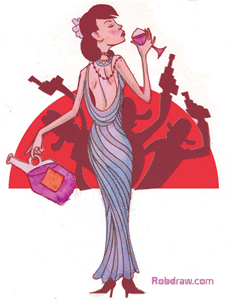As I have stated, I will not exclude plonk from this blog, nor will I draw the line at stupid human tricks involving plonk. I am not surprised that 5 liter boxed wine is required equipment for at least one drinking game. I am however surprised that 5 liter boxed wine has become the THEME of an apparently widely known drinking game. The game is called Slap the Bag, and I have found a number of descriptions of the "rules", but I like this particular version; it treats the topic with the dignity it does not deserve:
Slap-the-bag.
Slap-the-Bag plays an important role in all awesome parties, blackouts, and festivities. To set the record straight, and to clarify for everyone who wishes to partake in this wonderful competition, we are laying out the "official rules" of Slap-the-bag.
General guidelines:
1- Play is limited to 8 persons per bag of wine. One bag of wine shall be required for every 8 persons or part thereof.
2- Play shall include only Franzia brand boxed wine. Other brands have been known to leak or burst with repeated impact.
3- Slap-the-Bag may commence with a "practice-round." If you are a late joiner, you are not entitled to a "practice-round."
Rules of Play:
1- A game of slap-the-bag will commence with a chilled bag of wine being removed from the box. The player who purchased the wine is entitled to begin the competition, but is not obligated to do so. He may give the bag to a person of his choosing, who in turn must accept.
2- A player begins his turn by consuming a quantity of the wine. He then proceeds to slap the bag, hoping to make a valid "smack."
3- The rest of the players vote, gladiator style, on the volume/resonance of the players smack, to determine whether it was valid. If there is a majority "thumbs-up" the player will pass the bag by pitching or heaving towards the next player. The bag may not be handed off. Once passed, the next player shall begin his turn; see Rules of Play item 2.
4- Slap-the-Bag game is complete when the bag of wine is emptied. When consuming, you are not allowed to pause, or come up for air, or take a break. This will result in the end of your turn and play will proceed to the slapping and voting stage.
http://www.hulstonhigh.com/index.php
Pretty stoopid ... I was about to say "as far as drinking games go". But then I realized that I have no experience with drinking games, and there may be no such thing as a smart one. Thank goodness the rules prohibit use of decent quality boxed wine.
 A post yesterday on the Life Begins at Sixty-Five blog reminded me of a tip I read recently, and brought into focus how it relates to boxed wine. I don't even remember where I read this tip, but it stuck with me because it was very simple. I'm calling it the Fifteen Minute Rule. The idea was that you take the white wine out of the refrigerator 15 minutes before serving; you put the red wine into the refrigerator 15 minutes before serving. The result is that, red, or white, the wine is tempered just about right for drinking.
A post yesterday on the Life Begins at Sixty-Five blog reminded me of a tip I read recently, and brought into focus how it relates to boxed wine. I don't even remember where I read this tip, but it stuck with me because it was very simple. I'm calling it the Fifteen Minute Rule. The idea was that you take the white wine out of the refrigerator 15 minutes before serving; you put the red wine into the refrigerator 15 minutes before serving. The result is that, red, or white, the wine is tempered just about right for drinking.




